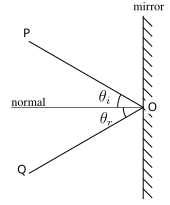Reflection
This article does not have any sources. (November 2024) |
Reflection is the change in direction of a wave at a boundary between two different media, so that the wave moves back into the medium it came from.

The most common examples include the reflection of light, sound and water waves.

Specular reflection is a mirror-like reflection of light from a surface, in which light from a single incoming direction is reflected into a single outgoing direction. In the diagram to the right, a light ray is coming from the point P, and meets at the mirror at point O. The ray reflects at the point O outwards in the same medium towards point Q. Reflection is measured relative to a line through point O that is at 90˚ to the mirror. The angles made by the light ray (shown in the diagram as and ) must be equal. Both angles have to be equal whenever reflection occurs. This is known as the "law of reflection".
People make many things to use reflections, including reflecting telescopes, radar, sonar, and lidar and putting light reflectors on things they want to see.

